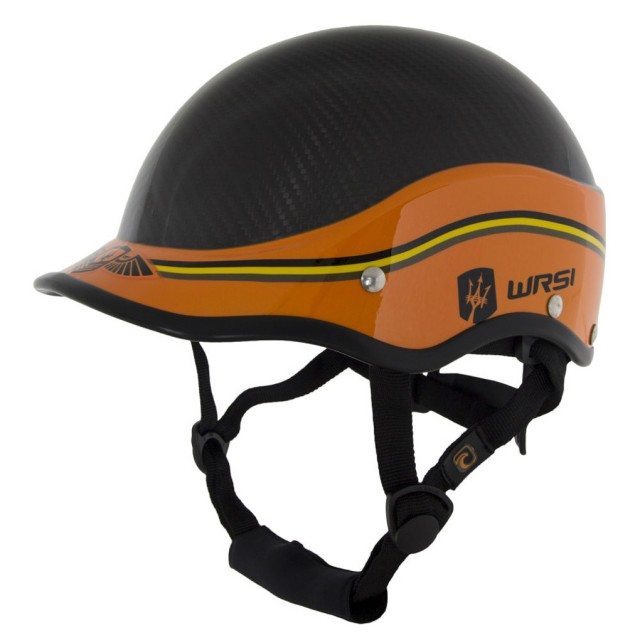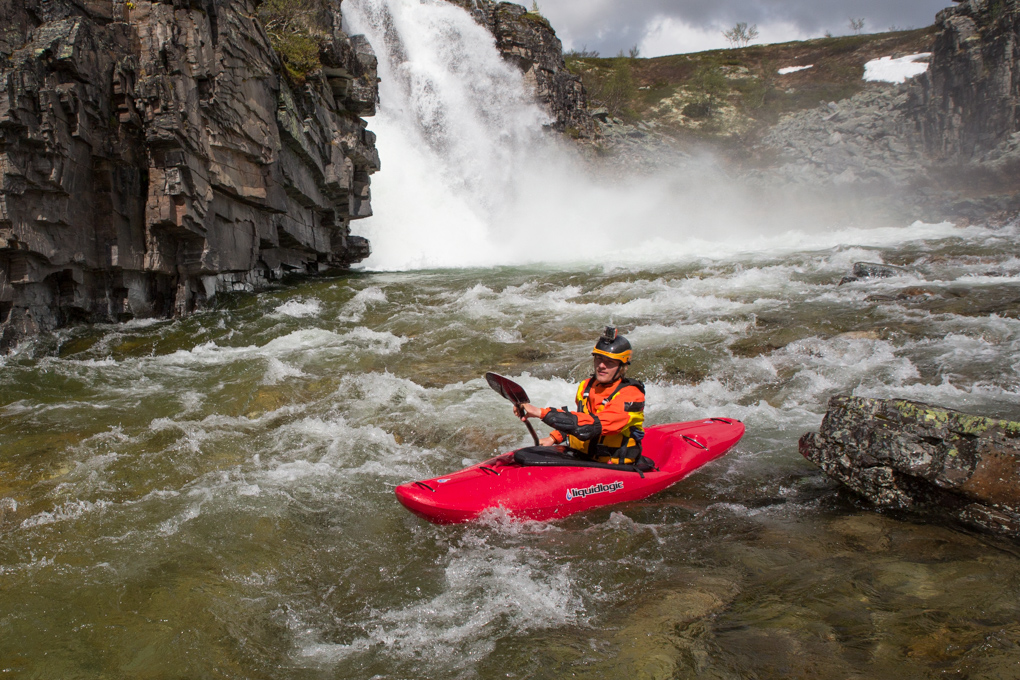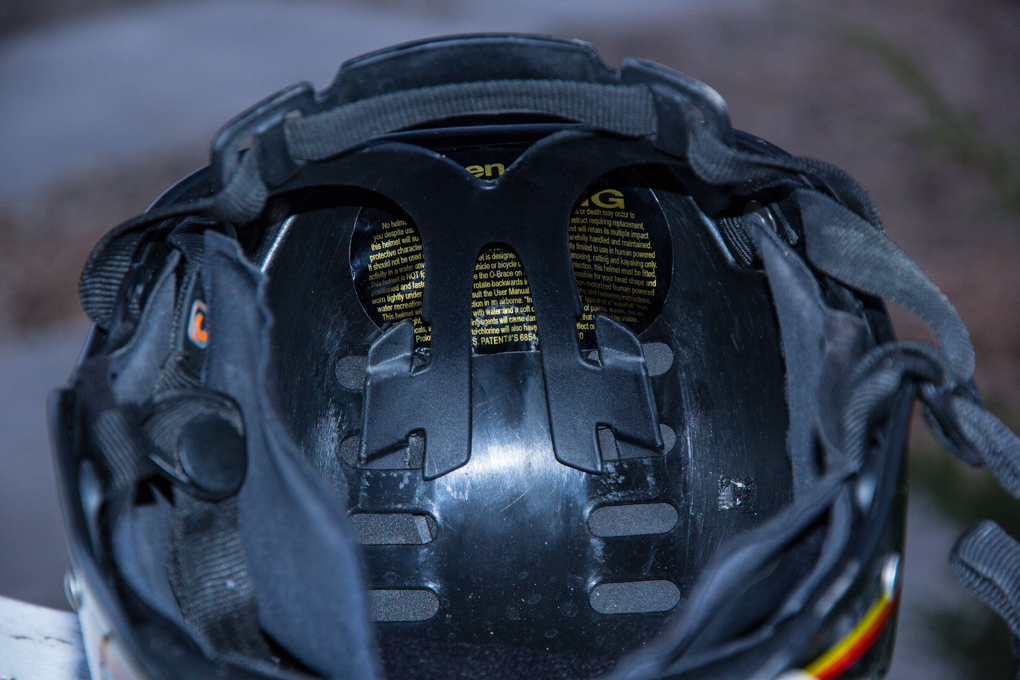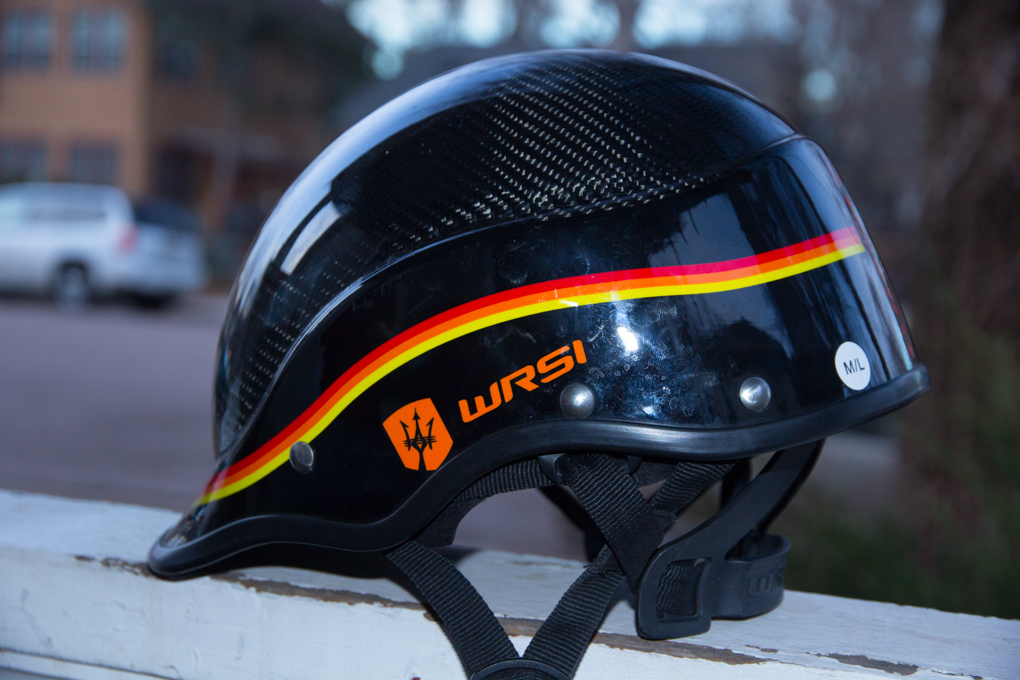
WRSI Trident Helmet
Size Tested: M/L
Specs:
- Carbon composite outer shell
- Customizable fit kit
- O-Brace harness
- Ear coverage: no
MSRP: $167.95
Test Locations: Virginia, Colorado
Uses: Kayak Instruction, Playboating, SUP
Days Tested: 25
Reviewer Info: Head circumference: 59cm, oval-shaped
Following the death of a family member, the Turner family founded WRSI to create safe and affordable helmets for whitewater paddlers. Their original helmet model, the Current, featured a plastic outer shell, but WRSI later added the Trident to their lineup.
The Trident is a lightweight carbon design with a sleek ball-cap style for sun protection. Due to their similarities, I will compare many features of the Trident to the Sweet Strutter. Both of these helmets are relatively low volume, light weight, and provide sun protection for the eyes and face.
Design
The Trident has a relatively low-profile design that sits above the ears, and drops down to partially cover the nape of the neck. The outer shell is made of carbon fiber, which makes the helmet stiff and light.
WRSI helmets feature a three-layer system composed of an outer shell, shock absorbing foam, a plastic inner shell, and customizable fit pads that double as shock absorbing foam. And in my experience, WRSI helmets absorb impacts well. When I first bought a WRSI Current as a teenager, I tested it by banging my head against a wall while wearing the helmet. The impact was barely noticeable, although the wall still has a nice dent. That being said, I have yet to take any big hits with the Trident on the river.

The Trident’s carbon shell will distribute impact forces differently than the Current’s plastic shell.
A plastic shell allows the helmet to withstand multiple impacts. That’s a definite advantage over composite helmets, which are typically severely compromised after a single major impact.
I haven’t found any statements from WRSI saying the Trident can withstand multiple impacts, so I suspect that energy dissipation isn’t as efficient once the Trident’s carbon shell is compromised. This is a tradeoff between multiple impact protection and a lighter, stiffer helmet.
The most useful feature on the Trident is the wide brim at the front of the helmet. The brim doesn’t protrude excessively far from the helmet, but wraps around and effectively shade my face from the sun. At first I was skeptical of how well this would work, especially after seeing the large, protruding ball-cap brim on the Strutter, but the Trident’s brim performed much better than I expected.
I primarily used the Trident while instructing kayaking this past summer, and the brim trumped all other features for the sun protection it offered. In my opinion, the sun protection is better than the Strutter because the brim is slightly wider, offering side-to-side coverage that is useful when the sun is not directly overhead. The brim also doesn’t interfere with my vision, whereas the Strutter protrudes far enough the in front to be visually noticeable above my eyes.
In short, while the Trident’s brim doesn’t look as impressive or as large as the Strutter’s, it’s actually more functional and provides better protection from the sun.
Fit and Sizing
Fit on WRSI helmets can be hit or miss. From what I’ve seen, either they work perfectly for you, or the fit feels very loose. Paddlers with rounder heads (as opposed to ovular) have better fit results because of the round shape of the helmet. The Trident has a large, round shell that stops just above the occipital lobe in the back of the head, wraps around the top of the ears, and continues to cover the temples in the front of the head.
The fit kit comes with three (small, medium, and large) full-coverage inner pads with different thicknesses for varying fit. These pads are quite substantial and cushion the helmet nicely.
The downside to this is that the helmet becomes quite thick after padding is added to the three-layer shell. My head shape doesn’t work perfectly with WRSI helmets, and I often feel like the helmet is simply sitting on top of my head instead of surrounding it. I hesitate to wear the Trident on rocky, hard whitewater, as I’ve experienced the helmet shifting on my head quite a bit while play boating in strong holes.
On the other hand, I know paddlers who wear the WRSI Current, which has similar fit characteristics, and regularly use it while running Class V.
The takeaway here is that it’s probably smart to try on the Trident at a shop and play around with the fit pads to achieve a fit that works for you. Or if there isn’t a store near where you live, order from an online retailer that allows returns for fit issues.
The first step to fitting the Trident is picking the correct size inner pad for the helmet. The pads attach to the plastic inner shell via adhesive velcro.
An adjustable O-Brace harness in the rear of the helmet prevents the Trident from riding up and exposing my forehead. This aspect of fit is crucial for any helmet with a brim, because the extra surface above the forehead area tends to catch water in holes or when resurfacing off of waterfalls, pushing the helmet out of place. Despite a snug fit with the straps and the O-Brace, the Trident would often be pushed back on my head in holes. These forces were enough to move the helmet out of place and slightly expose my forehead. With just a little bit of a struggle, the O-Brace can move up or down via four slots in the rear of the plastic shell.

The O-Brace can also be tightened against the neck by adjusting the ear straps, but the helmet still had quite a bit of lateral movement even with the brace fully cinched against my neck. Sweet helmets have a padded ratchet system (OCCIGRIP), which secures the helmet right below the occipital lobe. The Sweet system securely grips the back of the head and keeps the helmet very stable and secure compared to WRSI’s O-brace system. The brace can also cause some chafing, so be sure to adjust the brace position until it is resting comfortably against your neck.

I feel much safer with the Sweet OCCIGRIP system securing my helmet from all angles. The interior shape of the Sweet helmets better fit ovular heads like mine, allowing me to achieve a more secure fit.
